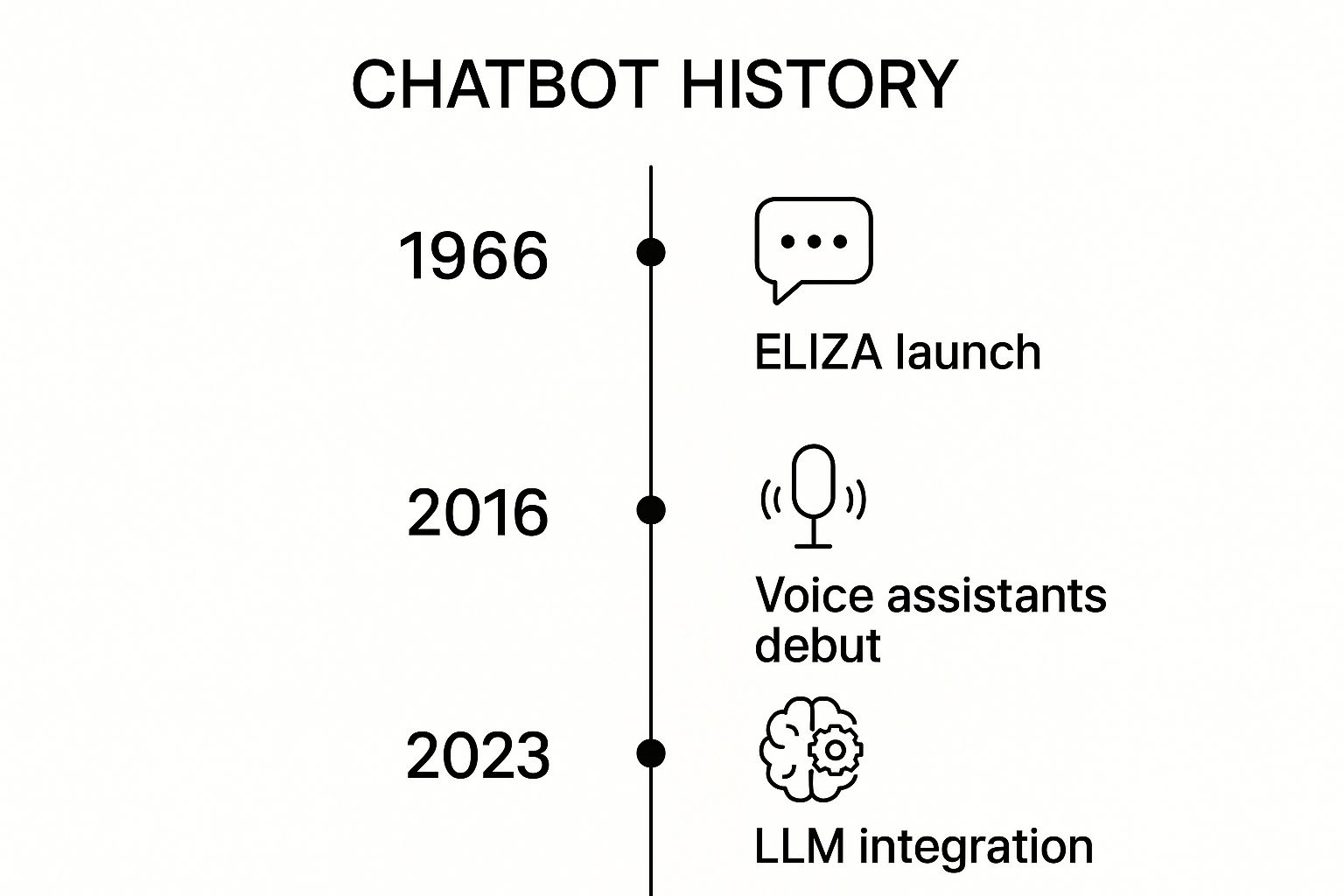build a chatbot
chatbot development
AI automation
bot creation
customer service
How to Build a Chatbot: Your Complete Success Blueprint
Understanding Why Now Is the Perfect Time to Build a Chatbot
The chatbot landscape has changed dramatically, creating a prime opportunity for businesses to integrate this technology. But why is now the ideal moment? A combination of factors, from advancements in core technologies to changing consumer expectations, makes this the perfect time to explore chatbot development.
The Rise of Conversational AI
One of the most significant reasons is the progress made in artificial intelligence (AI) and natural language processing (NLP). These advancements enable chatbots to understand and respond to human language with increasing accuracy and sophistication. Chatbots are now capable of handling more complex interactions, moving beyond simple, pre-programmed answers and engaging in dynamic, context-aware conversations. For instance, instead of providing generic FAQ responses, modern chatbots can interpret a customer's question and offer personalized solutions.

This infographic traces the evolution of chatbots from ELIZA in 1966 to the advanced, LLM-powered chatbots of 2023. It highlights the rapid acceleration of conversational AI capabilities, which allows for the development of sophisticated and effective chatbot solutions. This swift progress, along with growing consumer demand for instant, personalized support, makes today's environment perfect for integrating chatbots. The global chatbot market has also witnessed significant growth, expanding from USD 396.2 million in 2019 to approximately USD 7.76 billion by 2024. Projections indicate continued growth, with the market expected to reach USD 27.3 billion by 2030.
The following table offers a more detailed view of this growth trajectory:
Chatbot Market Growth Timeline
| Year | Market Size (USD) | Growth Rate | Key Drivers |
|---|---|---|---|
| 2019 | 396.2 million | - | Initial adoption, rising customer service demands |
| 2024 | 7.76 billion | Significant increase | Advancements in AI/NLP, increased consumer acceptance |
| 2030 | 27.3 billion | Continued growth | Expanding applications across industries, increased demand for automation |
This table highlights the significant growth of the chatbot market, driven by technological advancements and increasing business adoption. The projected growth emphasizes the long-term potential of chatbots in transforming customer interactions and business operations. For more detailed market statistics, you can visit Botpress to discover more insights about chatbot market growth.
Enhanced Customer Experience and Operational Efficiency
Beyond technological progress, changing consumer behavior also contributes to the importance of building a chatbot now. Today's customers expect instant, personalized service around the clock. Chatbots provide a seamless solution, offering immediate support, answering questions, and resolving issues promptly, resulting in improved customer satisfaction and brand loyalty.
Chatbots also deliver substantial benefits to businesses by increasing operational efficiency. They can handle a high volume of customer interactions simultaneously, allowing human agents to focus on more complex or specialized tasks. This allows companies to improve customer service while also reducing operational costs. Building a chatbot, therefore, becomes a smart investment for businesses aiming to improve customer experience and streamline operations. The capacity to automate repetitive tasks and provide consistent, 24/7 service makes chatbots a valuable tool in today's competitive business world.
Choosing Your Chatbot Platform Like a Pro
Choosing the right chatbot platform is crucial for your project's success. It impacts development time, costs, and how effective your chatbot will be. This section explores key factors to consider when selecting a platform that aligns with your needs and resources.
No-Code vs. Developer-Focused Platforms
One of the first decisions is choosing between no-code and developer-focused platforms. No-code platforms let you build chatbots without writing code. They're ideal for businesses with limited technical expertise, offering a visual, drag-and-drop interface. However, this ease of use can limit customization and scalability.
Developer-focused platforms offer more flexibility and control. They require coding experience but provide access to advanced features, APIs, and integrations. This makes them better for complex projects needing custom logic and integration with existing systems. For a deeper dive into chatbot development, check out this resource: How to master....
Key Features and Capabilities
Consider these essential features when evaluating chatbot platforms:
- Natural Language Processing (NLP): A strong NLP engine is vital for interpreting user input, understanding intent, and delivering relevant responses.
- Integrations: Seamless integration with your CRM, marketing automation, and other systems is essential for efficient data flow.
- Analytics and Reporting: Robust analytics tools give insights into user behavior, bot performance, and areas for improvement.
- Scalability: Ensure the platform can handle growth and increased traffic as your business expands.
- Security: Prioritize platforms with encryption, authentication, and compliance with industry security standards.
To help you compare different platforms, we've compiled a table summarizing their key features, pricing, and difficulty levels:
Introducing our Chatbot Platform Comparison table, a side-by-side comparison of popular chatbot building platforms. This table will give you a clear overview of the features, pricing, and complexity levels of different options to help you choose the best one for your business needs.
| Platform | Difficulty Level | Pricing | Best For | Key Features |
|---|---|---|---|---|
| Dialogflow | Beginner to Advanced | Free tier, paid plans | Businesses of all sizes | NLP, integrations, analytics, multi-language support |
| Chatfuel | Beginner | Free tier, paid plans | Small to medium businesses | No-code platform, easy to use, Facebook Messenger integration |
| ManyChat | Beginner | Free tier, paid plans | Small to medium businesses | No-code platform, marketing automation, Instagram integration |
| Amazon Lex | Advanced | Pay-as-you-go | Enterprises, developers | Advanced NLP, voice integration, AWS services integration |
| Microsoft Bot Framework | Advanced | Pay-as-you-go | Enterprises, developers | Open source, customizable, Azure services integration |
This table shows the diversity in available chatbot platforms. From no-code options like Chatfuel and ManyChat to more advanced platforms like Amazon Lex and Microsoft Bot Framework, there's a platform for varying technical skills and business needs. Choosing the right platform requires careful consideration of your specific requirements.
Evaluating Platforms: Questions and Red Flags
Ask these crucial questions:
- Does the platform align with our current and future technical skills?
- How easy is integration with our systems?
- What level of customization and control do we need?
- Does the platform's pricing fit our budget?
- Does the platform offer sufficient documentation, support, and training?
Watch out for these red flags:
- Lack of pricing transparency or hidden fees
- Limited integrations with vital business systems
- Poor documentation and customer support
- Negative reviews about platform reliability
Matching Platform to Business Needs
The best platform depends on your business needs and technical limitations. A small business with simple needs might choose a no-code solution, while a larger enterprise with complex integration needs might opt for a developer-focused platform. Consider your budget, technical skills, and long-term goals. Careful evaluation will ensure you select a platform that empowers you to build a chatbot that delivers results.
Creating Conversations That Actually Engage Users
The difference between a chatbot users adore and one they quickly abandon often hinges on conversation design. This involves creating engaging dialogues that feel natural and effectively guide users towards their goals. Building a truly resonant chatbot requires a deep understanding of user journeys, the psychology of interaction, and how to effectively structure dialogue.
Mapping User Journeys and Guiding Conversations
Effective chatbot conversations start with understanding what the user wants to achieve. Think of it like planning a road trip: you need to know your destination and the best route to get there. Similarly, successful businesses map user journeys within their chatbot to ensure conversations flow smoothly and efficiently towards specific business objectives. This involves identifying common user needs and designing conversational paths that address those needs clearly and concisely. For example, an e-commerce chatbot might guide a user through browsing products, selecting sizes, and finally, checking out.
The Psychology of Effective Chatbot Interactions
Just like in person, psychology plays a vital role in how users interact with chatbots. Users appreciate chatbots that are helpful, empathetic, and respectful. This means understanding user expectations and designing conversational flows that anticipate and address potential frustrations. Providing clear information, offering helpful suggestions, and acknowledging user input builds trust and promotes continued engagement. This creates a seamless and satisfying experience, much like a helpful store clerk guiding a customer. Chatbots have become essential for improving customer service, providing immediate support and personalized interaction. A crucial aspect of their success is their ability to understand and respond effectively to user queries. Technologies like AI and NLP have dramatically improved chatbot functionality, enabling them to handle more complex questions. For instance, generative AI chatbots like ChatGPT have gained significant market share, holding approximately 76.4% in 2025. Learn more about generative AI chatbot market share.
Developing Chatbot Personality and Dialogue Flows

A well-defined chatbot personality can greatly improve user engagement. This doesn't mean creating an overly quirky or excessively friendly persona. It means developing a consistent tone of voice and communication style that aligns with your brand and target audience. Consider whether your brand is formal or informal, playful or serious, and reflect that in your chatbot's language. Maintain a balance between personality and effectiveness. A friendly tone is welcome, but the primary goal is to assist users efficiently.
Structuring Dialogue for Reduced Frustration and Increased Completion
Structuring dialogue flows is crucial for minimizing user frustration and maximizing successful interactions. This includes:
- Providing clear options: Use buttons or quick replies to guide users and avoid open-ended questions that could cause confusion.
- Handling interruptions gracefully: Allow users to change topics or ask unrelated questions without derailing the entire conversation.
- Offering help and support: Provide easy access to help documentation or a human agent if needed.
- Confirming understanding: Use phrases like "Did I understand that correctly?" or "Is there anything else I can help you with?" to ensure user satisfaction.
By focusing on these strategies, you can create a chatbot that engages users effectively, streamlines their experience, and drives them towards desired actions that contribute to business success. Remember, creating a successful chatbot is an iterative process. Continuously analyze user interactions and adjust your chatbot's design for long-term success.
Building and Integrating Your Chatbot for Real-World Success
Building a chatbot involves more than just clever conversation design. It requires careful technical execution. This section dives into proven implementation strategies gleaned from successful deployments across diverse businesses. You'll learn how to integrate your chatbot smoothly, prioritize security, and tackle common technical challenges.
Seamless Integration With Existing Systems
Integrating your chatbot with your existing business systems is crucial for a successful deployment. This often involves connecting to CRM platforms like Salesforce, databases, and other third-party services. Think of it like adding a new room to your house. You want it to connect seamlessly with the existing structure, plumbing, and electrical systems.
Similarly, your chatbot should integrate smoothly with your current operations without causing disruptions. This might involve utilizing APIs to exchange data between your chatbot and your CRM, ensuring that customer interactions are logged and accessible across your business. Learn more in our article about How to master chatbot implementation steps.
Security Considerations: Protecting Your Data and Your Customers
Security is paramount when building and integrating a chatbot. You are responsible for protecting both your sensitive business data and your customers' personal information. This means implementing robust security measures like encryption and authentication.
You also need to ensure compliance with relevant data privacy regulations like GDPR and CCPA. This is like installing a strong security system in your new room to protect valuable possessions and ensure the safety of occupants.
Testing and Quality Assurance: Ensuring Real-World Reliability
Thorough testing is essential for any chatbot implementation. This involves testing the chatbot's performance under realistic conditions, including high traffic volumes and unexpected user inputs. You should perform various tests, including unit testing, integration testing, and user acceptance testing (UAT).
Think of this as rigorously inspecting the new room's construction. Ensure that the walls are sturdy, the windows are sealed, and the electrical system is safe. Similarly, testing verifies that your chatbot functions reliably under real-world pressures.
Tackling Common Technical Challenges
Even with meticulous planning, you may encounter technical hurdles during implementation. Some frequent challenges include API limitations, data synchronization issues, and scaling difficulties as user volume increases. Successful businesses anticipate these potential roadblocks and develop strategies to overcome them.
For example, imagine your new room's doorway is too narrow to move furniture in. You would need to widen it. Likewise, you may need to find workarounds for API limitations or implement caching mechanisms to improve data synchronization.
Implementation Sequence: Minimizing Risk, Maximizing Success
The order in which you implement your chatbot can greatly influence its success. A phased approach, starting with a pilot program and gradually expanding functionality, can minimize risk and allow for adjustments based on real-world feedback. This is like furnishing your new room gradually. You start with the essentials and then add more items as needed, ensuring that the space remains functional and comfortable throughout the process.

A similar approach to chatbot deployment enables you to gather valuable insights and make necessary improvements before a full-scale launch. This controlled rollout allows for fine-tuning and optimization, leading to a more robust and effective chatbot solution. By following a strategic implementation sequence, you maximize the chances of a smooth, successful launch and create a chatbot that delivers real business value.
Real-World Applications That Drive Measurable Results
Understanding how different industries use chatbots can inspire your own implementation strategy. This section explores applications generating real ROI across diverse sectors like e-commerce, healthcare, education, and financial services. We'll delve into the use cases that consistently deliver the highest returns and demonstrate how you can adapt these successful strategies to your specific needs.

E-Commerce: Boosting Sales and Customer Satisfaction
In the fast-paced world of online retail, chatbots play a crucial role. They enhance the customer experience and drive sales growth. For example, chatbots can provide personalized product recommendations based on a customer's browsing history and past purchases. This leads to increased conversions and higher average order values.
Chatbots can also answer customer questions instantly. This quick response time reduces cart abandonment rates and improves overall satisfaction. Features like automated order tracking and shipping updates keep customers informed and engaged throughout their buying journey.
Healthcare: Improving Patient Engagement and Access
Chatbots are transforming healthcare by offering efficient and accessible patient support. They can handle frequently asked questions about appointments, insurance coverage, and medical procedures. This allows healthcare staff to focus on more critical tasks.
Moreover, chatbots can facilitate appointment scheduling, send medication reminders, and even offer basic health information. This improves patient engagement and streamlines administrative work, leading to enhanced operational efficiency and better patient outcomes.
Education: Enhancing Learning and Support
The education sector is benefiting from chatbot technology. Chatbots can serve as virtual teaching assistants, providing students with personalized support and guidance. They can address questions about assignments, coursework, and administrative procedures. This frees up educators' time for more direct instruction.
Chatbots can also deliver interactive learning experiences, assess student understanding, and offer targeted feedback. This personalized approach improves learning outcomes and creates a more engaging educational experience.
Financial Services: Streamlining Transactions and Support
In the financial sector, chatbots are valuable tools for improving customer service and streamlining transactions. They can manage routine inquiries about account balances, transaction history, and service fees. This reduces wait times and improves customer satisfaction.
Chatbots can also assist with fraud detection and prevention, ensuring the security of customer financial information. This builds customer trust and reduces operational costs for financial institutions. The use of chatbots has expanded across various industries, from customer service and e-commerce to healthcare and education. Their applications range from simple tasks like answering FAQs to more complex roles such as personalized product recommendations and health advice.
The growing adoption of chatbots is driven by the need for efficient and cost-effective customer service solutions available 24/7. By 2025, the global chatbot market was valued at approximately USD 5.84 billion. Find more detailed statistics here. This demonstrates the potential benefits of implementing a chatbot strategy across various sectors.
Adapting Proven Strategies to Your Industry
While these examples highlight the potential of chatbots, successful implementation requires tailoring proven strategies to your specific business needs. This involves identifying the unique requirements of your target audience and aligning your chatbot's functionality with your overall business goals.
By carefully analyzing your industry’s challenges and learning from successful implementations in similar situations, you can build a chatbot that delivers measurable results. This targeted approach will ensure your chatbot investment contributes to your overall business success.
Measuring What Matters and Optimizing for Growth
Creating a chatbot is just the beginning. The real work starts with optimizing its performance using real-world data. This means understanding the key performance indicators (KPIs) that drive business success and using the right tools to track them. It's like launching a new product; you wouldn't just release it and cross your fingers. You'd track sales, customer feedback, and other important metrics to see what's working and what's not.
Key Performance Indicators for Chatbot Success
Several KPIs are essential for gauging chatbot effectiveness. User satisfaction is a primary metric, reflecting how well the chatbot meets user needs. This can be measured through surveys, feedback forms, and sentiment analysis of chat transcripts. For more information, check out this article on How to collect customer feedback. Another important KPI is the conversation completion rate. This measures how often users successfully achieve their goals through the chatbot, like completing a purchase, scheduling an appointment, or finding an answer to their question.
It’s also important to track the business impact of the chatbot. This could include metrics like an increase in sales conversions, reduced customer service costs, or improved lead generation. Demonstrating a clear return on investment (ROI) to stakeholders is vital for securing continued investment in the chatbot program.
Analytics Tools and Techniques for Optimization
Many analytics tools can help you monitor these KPIs and find areas for improvement. Many chatbot platforms offer built-in analytics dashboards providing data on user behavior, conversation flows, and bot performance. Third-party analytics tools like Google Analytics can also offer deeper insights into user engagement and sentiment. These tools help identify conversation bottlenecks and user drop-off points, allowing you to address them proactively. For example, a high drop-off rate at a specific point in the conversation may indicate a need to revise the dialogue flow or provide clearer information.
Strategies for Continuous Improvement
Chatbot optimization is a continuous process. A/B testing different dialogue flows is one effective strategy. This involves presenting different versions of a conversation to different user groups and measuring which performs better. This is similar to how marketers A/B test different website designs to optimize conversions. Another vital strategy is updating responses based on real user feedback. Analyzing user interactions and incorporating their suggestions helps create a more user-friendly and effective chatbot experience.
As your business grows and customer needs change, you'll need to scale your chatbot's capabilities. This might involve integrating new features, expanding the knowledge base, or adding support for multiple languages. Staying current with advancements in artificial intelligence (AI) and natural language processing (NLP) is also part of continuous improvement. By consistently refining and expanding the chatbot's functionality, you ensure it remains a valuable asset, delivering meaningful results for your business.
Key Takeaways
Building a chatbot can significantly benefit your business, but success hinges on careful planning, execution, and ongoing optimization. This section summarizes key takeaways into actionable steps.
Choosing the Right Platform
Your platform choice is the foundation of your chatbot project. A no-code platform can expedite development if you have limited technical expertise, while a developer-focused platform offers greater customization and scalability. Surprisingly, even no-code platforms can be powerful. As Josh W Comeau's intricate blog demonstrates, even seemingly simple platforms like Next.js can handle significant complexity with the right approach.
-
Key questions to consider: Does the platform integrate with your existing systems? How much customization is needed? What level of support is provided?
-
Potential red flags: Hidden fees, limited integrations, and poor support can quickly derail projects.
-
Recommendation: Balance your technical skills, budget, and long-term goals. AnotherWrapper offers a robust platform for building complex chatbots, providing flexibility and features for both technical and non-technical users.
Designing Engaging Conversations
A successful chatbot must engage users effectively, going beyond simply providing answers. This involves understanding user journeys and crafting conversational flows that seamlessly guide users toward their goals. Just like a well-written blog post, each interaction should contribute to a cohesive and compelling experience.
-
Focus on user journeys: Design conversations as a roadmap, guiding users to their destination.
-
Emphasize clarity: Provide clear options and avoid confusing open-ended questions.
-
Maintain consistent personality: Develop a brand-aligned tone of voice.
-
Prioritize helpfulness: Offer assistance and support throughout the interaction.
Building and Integrating Your Chatbot
Technical implementation is as crucial as conversation design. Seamless integration with your existing systems and strong security are vital. Testing and optimization ensure your chatbot remains valuable.
-
Integration: Seamlessly connect your chatbot with your CRM, database, and other services.
-
Security: Prioritize encryption, authentication, and data privacy compliance.
-
Testing: Rigorous testing is essential for real-world reliability, just as a developer tests their code.
-
Implementation: A phased approach minimizes risks and allows for iterative improvements.
Measuring and Optimizing for Growth
Launching your chatbot isn’t the end. Continuous monitoring and optimization are essential for long-term success.
-
Key metrics: Track user satisfaction, conversation completion rates, and business impact.
-
Analytics tools: Use available tools to identify bottlenecks and areas where users drop off.
-
Continuous improvement: Implement A/B testing, gather user feedback, and make updates based on performance data.
Building a Chatbot with AnotherWrapper
AnotherWrapper provides the tools and resources to build and deploy sophisticated chatbots efficiently. With 10 customizable demo applications, including advanced chatbots, AnotherWrapper accelerates development and allows you to focus on user experience. The platform’s built-in Supabase integration for authentication, database, and vector embeddings simplifies complex tasks, while essential services like payments, analytics, email, and programmatic SEO streamline the entire process. Whether you're a seasoned developer or an entrepreneur, AnotherWrapper offers an all-in-one solution to build a chatbot and launch your next AI-powered project. Explore AnotherWrapper today: Learn more about AnotherWrapper.
Fekri




